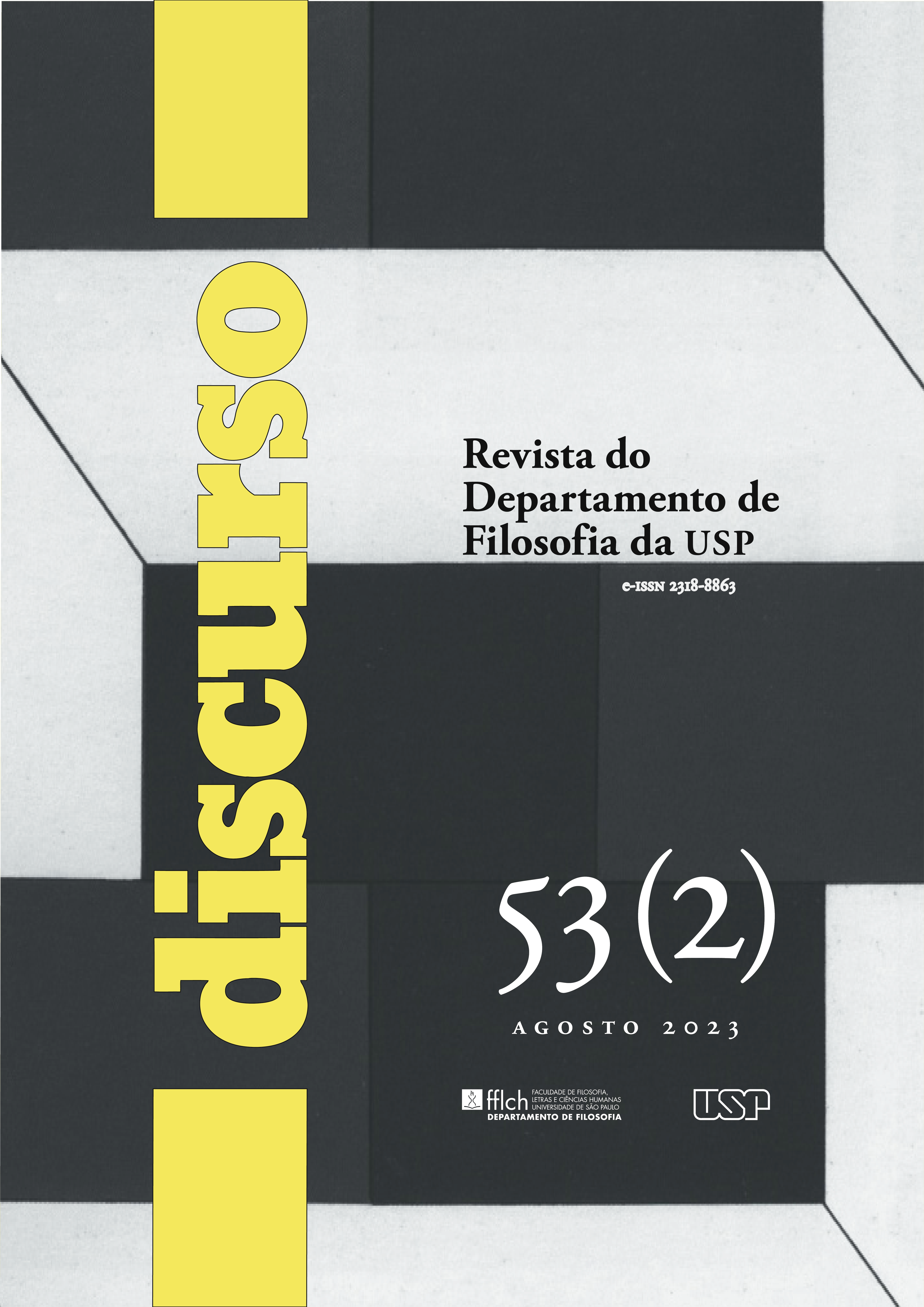A centralidade da arte para a Crítica da faculdade do juízo
DOI:
https://doi.org/10.11606/issn.2318-8863.discurso.2023.215679Palavras-chave:
Kant, belo, arte, voz universal, sensus communisResumo
Embora seja comum reconhecer no belo natural o caso mais paradigmático para a argumentação que Kant desenvolve na Crítica da faculdade do juízo estética, encontramos reiteradas considerações sobre a arte na “Dedução transcendental” exposta nos §§30-38. Neste trabalho, argumento que há duas centralidades distintas em operação nessa obra. O belo natural é paradigmático porque sua predicação é a que melhor representa o ideal de pureza que corresponderia ao ajuizamento integralmente fundado em faculdades transcendentais; mas o belo artístico também pode ser considerado paradigmático, pois é por meio dos juízos sobre ele que melhor nos aproximamos de tal ideal.
Downloads
Referências
Abaci, U. (2008). “Kant’s Justified Dismissal of Artistic Sublimity”. Journal of Aes-thetics and Art Criticism, v. 66, n. 3, p. 237-251.
Abaci, U. (2010). “Artistic Sublime Revisited: Reply to Robert Clewis”. Journal of Aesthetics and Art Criticism, v. 68, n. 2, p. 170-173.
Allison, H. E. (2001). Kant’s Theory of Taste: A Reading of the Critique of the Aesthet-ic Judgment. Cambridge: Cambridge University.
Clewis, R. (2010). “A Case for Kantian Artistic Sublimity: A Response to Abaci”. Journal of Aesthetics and Art Criticism, v. 68, n. 2, p. 167-170.
Crawford, D. W. (1974). Kant’s Aesthetic Theory. Madison: University of Wiscon-sin.
Dobe, J. K. (2010). “Kant’s Common Sense and the Strategy for a Deduction”. The Journal of Aesthetics and Art Criticism, v. 68, n. 1, p. 47-60.
Friedlander, E. (2017). “On Common Sense, Communicability, and Community”. In: Altman, Matthew C. (org.). The Palgrave Kant Handbook. London: McMil-lan, p. 407-424.
Guyer, P. (1978). “Interest, Nature, and Art: A Problem in Kant’s Aesthetics”. The Review of Metaphysics, v. 31, n. 4, p. 580-603.
Guyer, P. (1997). Kant and the Claims of Taste. Cambridge: Cambridge University.
Kant, I. (1902-). Gesammelte Schriften (Akademische Ausgabe). Berlim: Hrsg. von der Königlich-Preussischen Akademie der Wissenschaften zu Berlin.
Kemal, S. (1991). “Kant, Community and the Evil Poem”. Revue Internationale de Philosophie, v. 14, n. 176, p. 24-38.
Matherne, S. (2019). “Kant on Aesthetic Autonomy and Common Sense”. Philo-sopher’s Imprint, v. 19, n. 24, p. 1 -22.
Nehring, R. (2010). Kritik des Common Sense: Gesunder Menschenverstand, reflektie-rende Urteilskraft und Gemeinsinn. Der Sensus communis bei Kant. Berlim: Duncker & Humblot.
Pillow, K. (1994). “Form and Content in Kant’s Aesthetics: Locating Beauty and the Sublime in the Work of Art”. Journal of the History of Philosophy, v. 32, n. 3, p. 443-459.
Pippin, R. B. (1996). “The Significance of Taste: Kant, Aesthetic and Reflective Judgment”. Journal of the History of Philosophy, v. 34, n. 4, p. 549-569.
Quintana, L. (2013). “The Judgment of Taste in a Cosmopolitan Sense”. In: Ba-cin, S.; Ferrarin, A.; La Rocca, C.; Ruffing, M. (orgs.). Kant und die Philosophie in weltbürgerlicher Absicht: Akten des XI. Internationalen Kant-Kongresses, Bd. 4. Berlim/Boston: De Gruyter, p. 203-214.
Rind, M. (2000). “What Is Claimed in a Kantian Judgment of Taste?”. Journal of the History of Philosophy, v. 38, n. 1, p. 63-85.
Rogerson, K. F. (1982). “The Meaning of Universal Validity in Kant’s Aesthetics”. The Journal of Aesthetics and Art Criticism, v. 40, n. 3, p. 301-308.
Stoner, S. A. (2019). “Kant on Common-sense and the Unity of Judgments of Taste”. Kant Yearbook, v. 11, n. 1, p. 81-99.
Wicks, R. (1995). “Kant on Fine Art: Artistic Sublimity Shaped by Beauty”. Jour-nal of Aesthetics and Art Criticism, v. 53, n. 2, p. 189-193.
Zhouhuang, Z. (2016). Der sensus communis bei Kant: Zwischen Erkenntnis, Mora-lität und Schönheit. Berlim: De Gruyter.
Downloads
Publicado
Edição
Seção
Licença
Copyright (c) 2023 Vladimir Vieira

Este trabalho está licenciado sob uma licença Creative Commons Attribution-NonCommercial-ShareAlike 4.0 International License.
O trabalho da Discurso foi licenciado com uma Licença Creative Commons Attribution-NonCommercial-ShareAlike 4.0 International.
Os autores aqui publicados mantém os direitos sobre seus artigos
De acordo com os termos seguintes:
-
Atribuição [BY] — Deve-se dar o crédito apropriado, prover um link para a licença e indicar se mudanças foram feitas.
-
NãoComercial [NC] — É proibido o uso deste material para fins comerciais.
-
CompartilhaIgual [SA] — Caso haja remixagem, transformação ou criação a partir do material, é necessário distribuir as suas contribuições sob a mesma licença que o original.




